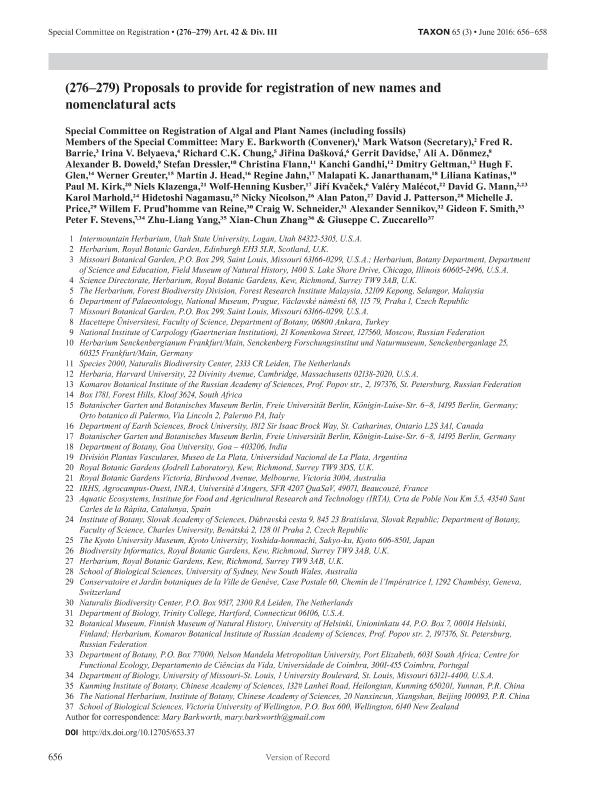Artículo
(276–279) Proposals to provide for registration of new names and nomenclatural acts
Barkworth, Mary E.; Watson, Mark; Barrie, Fred R.; Belyaeva, Irina V.; Chung, Richard C. K.; Dasková, Jirina; Davidse, Gerrit; Dönmez, Ali A.; Doweld, Alexander B.; Dressler, Stefan; Flann, Christina; Gandhi, Kanchi; Geltman, Dmitry; Glen, Hugh F.; Greuter, Werner; Head, Martin J.; Jahn, Regine; Janarthanam, Malapati K.; Katinas, Liliana ; Kirk, Paul M.; Klazenga, Niels; Kusber, Wolf-Henning; Kvacek, Jirí; Malécot, Valéry; Mann, David G.; Marhold, Karol; Nagamasu, Hidetoshi; Nicolson, Nicky; Paton, Alan; Patterson, David J.; Price, Michelle J.; van Reine, Willem F Prud' Homme; Schneider, Craig W.; Sennikov, Alexander; Smith, Gideon F.; Stevens, Peter F.; Yang, Zhu-Liang; Zhang, Xian-Chun; Zuccarello, Giuseppe C.
; Kirk, Paul M.; Klazenga, Niels; Kusber, Wolf-Henning; Kvacek, Jirí; Malécot, Valéry; Mann, David G.; Marhold, Karol; Nagamasu, Hidetoshi; Nicolson, Nicky; Paton, Alan; Patterson, David J.; Price, Michelle J.; van Reine, Willem F Prud' Homme; Schneider, Craig W.; Sennikov, Alexander; Smith, Gideon F.; Stevens, Peter F.; Yang, Zhu-Liang; Zhang, Xian-Chun; Zuccarello, Giuseppe C.
 ; Kirk, Paul M.; Klazenga, Niels; Kusber, Wolf-Henning; Kvacek, Jirí; Malécot, Valéry; Mann, David G.; Marhold, Karol; Nagamasu, Hidetoshi; Nicolson, Nicky; Paton, Alan; Patterson, David J.; Price, Michelle J.; van Reine, Willem F Prud' Homme; Schneider, Craig W.; Sennikov, Alexander; Smith, Gideon F.; Stevens, Peter F.; Yang, Zhu-Liang; Zhang, Xian-Chun; Zuccarello, Giuseppe C.
; Kirk, Paul M.; Klazenga, Niels; Kusber, Wolf-Henning; Kvacek, Jirí; Malécot, Valéry; Mann, David G.; Marhold, Karol; Nagamasu, Hidetoshi; Nicolson, Nicky; Paton, Alan; Patterson, David J.; Price, Michelle J.; van Reine, Willem F Prud' Homme; Schneider, Craig W.; Sennikov, Alexander; Smith, Gideon F.; Stevens, Peter F.; Yang, Zhu-Liang; Zhang, Xian-Chun; Zuccarello, Giuseppe C.
Fecha de publicación:
06/2016
Editorial:
International Association for Plant Taxonomy
Revista:
Taxon
ISSN:
0040-0262
Idioma:
Inglés
Tipo de recurso:
Artículo publicado
Clasificación temática:
Resumen
The Melbourne Congress of 2011 authorized a Special Committee on Registration of Algal and Plant Names (including fossils), which was established the following year (Wilson in Taxon 61: 878–879. 2012). Its explicit mandate was “to consider what would be involved in registering algal and plant names (including fossils), using a procedure analogous to that for fungal names agreed upon in Melbourne and included in the Code as Art. 42”, but expectations at the Nomenclature Section in Melbourne went farther than that. There was the hope that registration systems for at least some of the main groups would soon be set up, to be used and tested on a voluntary basis and, if found to be generally accepted, would persuade the subsequent Congress in Shenzhen, in 2017, to declare registration of new names an additional requirement for valid publication. The Melbourne Congress also approved mandatory registration of nomenclatural novelties in fungi, starting on 1 Jan 2013. The new Art. 42 of the Code (McNeill & al. in Regnum Veg. 154. 2012) requires authors to register any fungal nomenclatural novelty, prior to publication, with a recognized repository, whereupon they are provided with a unique identifier for each name, to be included in the protologue along with other Code-mandated information. Years before registration became mandatory, mycologists had been encouraged, often prompted by journal editors, to register their nomenclatural novelties prior to publication. Most complied. Consequently, when mandatory registration was proposed, it had strong support from the mycological community. There are currently three recognized repositories for fungal names. They vary somewhat in how they operate, but they share records of their registered novelties as soon as publication has been effected. One consequence of implementing mandatory registration is that locating new fungal names and combinations and associated protologue information is much simpler now than it was before. This makes it easier to incorporate the information into taxonomic studies and to update taxonomic treatments, inventories, and indices. A corollary is that, no matter what publication outlet an author chooses, the name cannot fail to be noticed. The positive experience in mycology makes extension of the registration concept to plants and algae a compelling idea. That experience shows that the best way to make mandatory registration of nomenclatural novelties palatable to botanists and phycologists is the establishment of trial registration at repositories with a history of involvement in and commitment to the indexing of names. Trial registration enables users to acquaint themselves with registration procedures, make suggestions on how they might be improved, and appreciate, by personal experience, the benefits of registration. Unfortunately, the task of establishing such repositories proved to be more complex and time-consuming than had been foreseen. Substantial progress has been made in the establishment of such centres (Barkworth & al., in this issue, pp. 670–672) but the Committee is not in a position to make firm proposals to regulate registration procedures, even less to make registration mandatory from a concrete future date. Nevertheless, the Committee sees it as imperative that the Shenzhen Congress be offered the opportunity to move forward with registration without having to wait six more years. In this spirit, we offer the proposals below. Proposal (276) would declare registration an ongoing concern of the botanical, mycological, and phycological community and provide the basic structure for making it possible. Proposal (277) and Prop. (278) would, in addition, define a flexible framework within which a system of voluntary registration could be developed for various categories of organisms. Proposal (279) would provide for future mandatory registration in a way that does not depend on the six-year intervals between International Botanical Congresses. Presentation of each proposal is followed by a summary of the support received from members of the Committee.
Palabras clave:
Nomenclature
,
Taxonomy
,
Plants
,
Proposals
Archivos asociados
Licencia
Identificadores
Colecciones
Articulos(CCT - LA PLATA)
Articulos de CTRO.CIENTIFICO TECNOL.CONICET - LA PLATA
Articulos de CTRO.CIENTIFICO TECNOL.CONICET - LA PLATA
Citación
Barkworth, Mary E.; Watson, Mark; Barrie, Fred R.; Belyaeva, Irina V.; Chung, Richard C. K.; et al.; (276–279) Proposals to provide for registration of new names and nomenclatural acts; International Association for Plant Taxonomy; Taxon; 65; 3; 6-2016; 656-658
Compartir
Altmétricas



